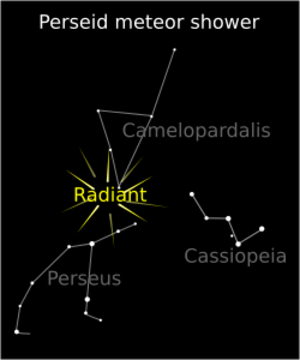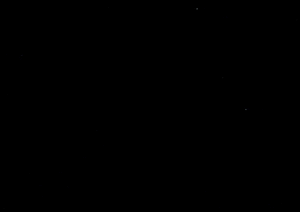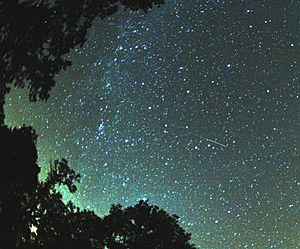Perseids facts for kids
Quick facts for kids Perseids (PER) |
|
|---|---|
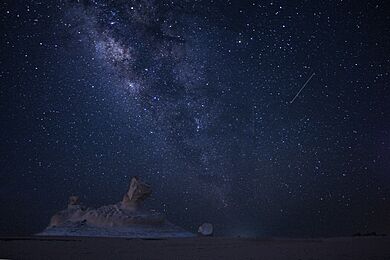
Perseids in 2017 as seen from the White Desert, Egypt
|
|
| Pronunciation | /ˈpɜːrsi.ədz/ |
| Discovery date | AD 36 (first record) |
| Parent body | Comet Swift–Tuttle |
| Radiant | |
| Constellation | Perseus and Cassiopeia (near HD 19557) |
| Right ascension | 03h 13m |
| Declination | +58° |
| Properties | |
| Occurs during | July 14 – September 1 |
| Date of peak | August 12 (August 13 for 2023) |
| Velocity | 58.8 km/s |
| Zenithal hourly rate | 100 |
The Perseids are a fantastic meteor shower that happens every year. It's like a cosmic light show in the night sky! These shooting stars are linked to a comet called Comet Swift–Tuttle. You can usually see them from mid-July to late-August. They are called Perseids because they seem to come from the direction of the constellation Perseus.
Contents
What's in a Name?
The name "Perseids" comes from an old Greek word, Perseidai. In Greek mythology, these were the sons of a hero named Perseus. So, it's like calling them "Perseus's children" because they appear near his constellation.
How Do We See the Perseids?
The Perseids are caused by tiny pieces of rock and dust left behind by Comet Swift–Tuttle. This trail of debris is called the Perseid cloud. As the comet travels on its long 133-year journey around the Sun, it leaves these particles behind.
Most of these particles have been floating in space for about a thousand years. But there's also a newer stream of dust that broke off the comet in 1865. This newer stream can sometimes cause a small "mini-peak" of meteors a day before the main show.
When Earth passes through this cloud of debris each year, these tiny particles, called meteoroids, hit our atmosphere. They burn up from the friction, creating bright streaks of light we call meteors or "shooting stars." Most Perseids burn up very high in the atmosphere, about 80 kilometers (50 miles) above the ground.
You can see the Perseids from mid-July every year. The best time to watch is usually between August 9 and 14. During this peak time, you might see 60 or more meteors every hour! They can appear anywhere in the sky.
Because of where they seem to come from (the constellation Perseus), the Perseids are best seen in the Northern Hemisphere. The best time to watch is usually in the hours before dawn. This is because that side of Earth is moving forward into the meteoroid stream, scooping up more particles. Sometimes, you can even see some before midnight. These might "graze" Earth's atmosphere, creating long, bright trails.
When Are the Best Times to Watch?
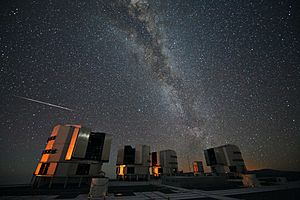
The table below shows when the Perseids have been active and when their peak viewing times were in recent years. The "Peak of shower" is when you can see the most meteors.
| Year | Perseids active between | Peak of shower |
|---|---|---|
| 2023 | July 14 – Sep 01 | August 13 08:00 UT (The Moon was a thin crescent, making it easier to see faint meteors.) |
| 2022 | July 17 – Aug 24 | August 12–13 (There was a full moon on Aug 12, which made it harder to see fainter meteors.) |
| 2020 | July 16 – August 23 | August 12–13 (Up to 100 meteors per hour were seen.) |
| 2019 | July 17 – August 24 | August 12–13 (Up to 80 meteors per hour were seen.) |
| 2018 | July 17 – August 24 | August 11–13 (Up to 60 meteors per hour were seen.) |
| 2017 | July 17 – August 24 | August 12 |
| 2016 | July 17 – August 24 | August 11–12 (This was a great year, with up to 150 meteors per hour!) |
History and Legends
Some people, especially Catholics, call the Perseids the "tears of Saint Lawrence". This is because the peak of the shower often happens around August 10. This date is when Saint Lawrence was martyred (died for his beliefs) in 258 AD. Legend says he was burned alive, and the shooting stars are like the sparks from his martyrdom.
In 1836, a scientist named Adolphe Quetelet noticed that there were more meteors in August. He studied old records and predicted that the peak would be around August 10. Other astronomers confirmed his prediction the next year!
Later, in 1866, an Italian astronomer named Giovanni Virginio Schiaparelli discovered the important link between meteor showers and comets. He figured out that the Perseids were indeed caused by the Comet Swift–Tuttle.
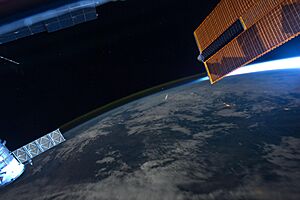
See also
 In Spanish: Perseidas para niños
In Spanish: Perseidas para niños


